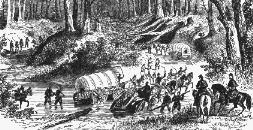The Battle of Poison Spring

The Battle of Poison Spring

Steele's army included some 13,000 men, 9,000 horses, and mules, 800 wagons and 30 pieces of Artillery. Supplying this army was proving to be a major problem. Steele later wrote that his supplies were nearly exhausted and so was the country. With men on half-rations for almost 3 weeks, it was almost impossible to enforce the commander's orders against unauthorized foraging.
On April 17, a train of 198 wagons was sent westward along the upper Washington Road to collect corn and other foodstuffs. After loading the wagons with corn, they camped 18 miles west of Camden. At sunup they began the march to Camden. Soon, the received reinforcements bringing the total force to 875 infantry (including the First Kansas Colored). 90 cavalry troopers, and a four gun battery of artillery including two mountain howitzers, and two rifled cannon.
The Confederates, observing this movement, gathered some 3100 cavalry, and 8 cannon under Brigadier Generals Samuel B. Maxey and John S. Marmaduke. The enemy was met about 14 miles west of Camden at a place called Poison Spring. The Confederates under Maxey blocked the Union Advance and together he and Marmaduke attacked the front and south flanks of the long forage train.
Several times the Federals tried to make a stand, only to be pushed back beyond the stalled train. After a fierce battle, including a furious charge by a regiment of Confederate Choctaw Indians, the Federals broke in rout and were pursued for about 2 miles. The train was stalled along present day Highway 79 on the south side of the state park. Fighting took place along both sides of the road.
The Confederates captured the four cannon, complete with limbers and caissons, 170 wagons (the others being burned) and teams, took over 100 prisoners, and buried 181 Federal troops. According to a Southern officer, the wagons contained:
...corn, bacon, stolen bed quilts, women's and children's clothing, hogs, geese and all the et ceteras of unscrupulous plunder.
301 Union soldiers were listed as killed or missing. Additionally, the loss created much indignation in the Union camp as well as aggravating the critical supply situation. Confederate losses were relatively small with 111 killed, wounded, or missing . The victory at Poison Spring, along with the arrival of General E. Kirby Smith with three infantry divisions, and the report of the defeat of Union General Banks in Louisiana, raised Confederate hopes that they could cut off the supply lines and capture the entire Union army.
Go to Red River Campaign
Go to Battle of Marks' Mills
Go to Battle of Jenkin's Ferry
Return to the Enlisted Man's Web Site